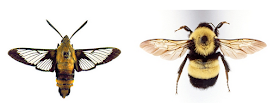 |
| Snowberry Clearwing Moth |
Although yesterday was Pet/Butterfly Day at Creasey Mahan Nature Preserve, my favorite finds were two moths which can be seen during the day. The clearwing moth flies and moves just like hummingbirds. Like them, they can remain
suspended in the air in front of a flower while they unfurl their long
tongues and insert them in flowers to sip their nectar. They even emit
an audible hum like hummingbirds. I've seen them called both hummingbird and bumble bee moths, since they mimic those two fliers.
 |
| Snowberry Clearwing Moth |
Hummingbird moths are rather plump; the tip of their tail opens into a
fan. They are usually of a rich reddish brown color, at least in part.
Like all Lepidoptera their wings are covered by scales; some species
lose many of the scales from patches on their wings, so they are called
clearwing hummingbird moths. Like most moths they have a very long
tongue which they carry rolled under their chins and that they use to
reach the nectar of long-necked flowers. Such nectar is inaccessible to
many other flower visitors, so it seems that these flowers prefer long
tongued pollinators and try to keep the others away.
 |
| Bumblebee Moth vs Bumblebee |
The adult Bumblebee Moth will feed on their
larval food plants, honeysuckle and snowberry, for nectar. They also
will get nectar from milkweed, Monardella, and some thistles.
Monardella is an excellent garden plant for butterflies as well as
Moths. It has perennial and annual forms from white to purple flowers.
It also has a fresh minty scent. The one I saw was feeding on butterfly bush.
 |
| Luna Moth |
This Luna moth was found on the side of the Field House, near the big security light that shines all night. Although rarely seen due to their very brief (1 week) adult lives, Luna Moths are considered common in some areas, but uncommon in others. As with all Saturniidae, the adults do not eat or have mouths. They emerge as adults solely to mate, and as such, only live approximately one week. They are more commonly seen at night.
 |
| Luna moth male - large antennae |
They have huge wingspans of 3 - 4 inches. The males are distinguished from the females by their larger and wider antennae, all the better to detect the pheromones of the female. Luna Moth caterpillars are lime green with orange spots running down
both sides. The caterpillars feed on several types of trees,
including, alder, beeches, cherries, hazelnut, hickories, pecan,
persimmon, sweet gum, and willows. The caterpillar molts five times before settling on a host plant where they spin their cocoon.
male Luna Moths release a
chemical at night which attracts males. Adults die shortly after
mating or laying eggs.





good information and sharp pictures; thanks for the comparisons
ReplyDelete